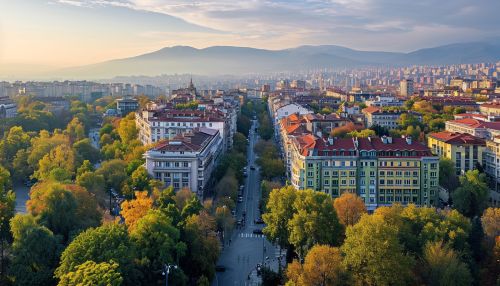Sofia
Geography
Sofia is the capital and largest city of Bulgaria. It is located in the western part of the country, on the lower slopes of Mount Vitosha, and is the administrative, cultural, economic, and educational centre of the country.


History
The history of Sofia dates back to the 8th millennium BC, making it one of the oldest cities in Europe. The city's history includes periods of Greek, Roman, Ottoman, and Soviet occupation, each leaving a distinct imprint on the city's architecture and culture.
Prehistoric and Ancient Times
Sofia's history begins with the Neolithic settlement of Slatina, located in the eastern part of the city. The Thracians established a settlement in the 5th century BC, which was later conquered by the Romans in the 1st century AD. The Romans named the city Serdica, and it became a significant regional centre.
Middle Ages
During the Middle Ages, Sofia was known as Sredets and was a significant fortress and administrative centre in the First Bulgarian Empire. The city was conquered by the Byzantine Empire in the 11th century and later by the Ottoman Empire in the 14th century.
Ottoman Rule and Liberation
Under Ottoman rule, Sofia was known as Sofya and experienced significant demographic and cultural changes. The city was liberated from Ottoman rule in 1878 during the Russo-Turkish War and became the capital of the newly independent Bulgaria.
20th Century to Present
In the 20th century, Sofia experienced rapid industrialization and growth, especially during the Communist era. Today, Sofia is a vibrant and modern city that retains its rich history and cultural heritage.
Demographics
As of 2021, Sofia has a population of over 1.3 million people, making it the 14th largest city in the European Union. The city has a diverse population, with a mix of ethnic Bulgarians, Turks, Roma, and other minority groups.
Economy
Sofia is the economic heart of Bulgaria, contributing to over 40% of the country's GDP. The city's economy is diverse, with sectors including information technology, telecommunications, transportation, and manufacturing playing significant roles. Sofia is also a regional hub for finance and commerce, with many multinational corporations having regional offices in the city.
Culture
Sofia is a city with a rich cultural heritage and a vibrant contemporary arts scene. The city is home to numerous museums, galleries, theatres, and cultural institutions, including the National Historical Museum, the Sofia Opera and Ballet, and the National Art Gallery.
Education
Sofia is the educational centre of Bulgaria, with numerous universities, colleges, and research institutions. The city is home to the oldest higher education institution in Bulgaria, Sofia University "St. Kliment Ohridski", and several other universities such as the Technical University of Sofia and the University of National and World Economy.
Transport
Sofia has a well-developed public transportation system, including a metro system, trams, buses, and trolleybuses. The city is also a major transportation hub, with the Sofia Airport serving as the busiest airport in Bulgaria.
